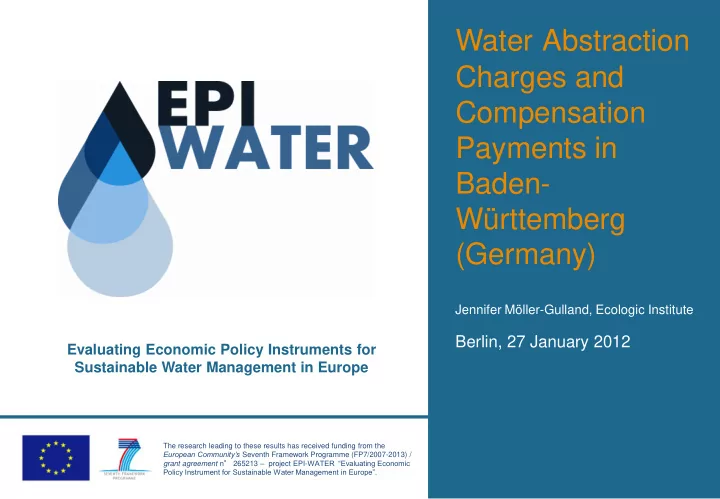

Water Abstraction Charges and Compensation Payments in Baden- Württemberg (Germany) Jennifer Möller-Gulland, Ecologic Institute Berlin, 27 January 2012 Evaluating Economic Policy Instruments for Sustainable Water Management in Europe The research leading to these results has received funding from the European Community’s Seventh Framework Programme (FP7/2007-2013) / grant agreement n ° 265213 – project EPI- WATER “Evaluating Economic Policy Instrument for Sustainable Water Management in Europe”.
1. Structure of the Presentation • Background • Problem definition • Solution: the policy mix • Environmental outcomes • Economic linkage within the policy mix • Conclusions 1
2. Background Background: • Location of case study: Baden-Württemberg • Around 11 million inhabitants • One of the wealthiest Länder in Germany • ~ 50% of land used by agriculture 2
3. Problem Definition • Since the 1970s: problems relating to groundwater quality from agricultural diffuse pollution • Two legislative changes in 1986 • Tightening of nitrate concentration thresholds for drinking water • Compulsory compensation payments to farmers restricted in agricultural practices • Problems: • Required decrease diffuse pollution from agriculture • Voluntary agreements unfeasible Needed: Centralized action and compensation payments ... But where would the money come from...? 3
4. Solution: The Policy Mix 1. Regulation on Protected Areas and Compensatory Payments (SchALVO) – within water protected areas (1988) • Monitored via samples of soil nitrate levels 2. Water abstraction charges – levied on actual water abstracted (1988) • Designed as funding for SchALVO (among others) • But: revenues legally not permitted to be earmarked for SchALVO • “Re - marketed” as EPI with its own objectives 3. Market Relief and Cultural Landscape Compensation (MEKA) – outside of water protected areas (1992) 4
5. Environmental Outcome – SchALVO vs MEKA 30 29.2 Measurements 29.2 28.7 29 outside water MEKA protected areas 28 - 5.7 mg N/l 27.5 27.4 27.3 (-19.5%) Concentration of nitrate in mg/l 27 26.8 27 26.5 26.9 Measurements 26.9 inside water 25.8 25.7 26 25.5 protected areas 26.1 25.1 25.1 25.8 24.9 25 25.4 24.9 24.8 23.9 Baseline 24 24.4 23.5 outside water 23.3 23.9 23.9 SchALVO protected areas - 4.3 mg N/l 23.5 23.5 23.5 23.5 23 (-16%) 23.2 23 22.6 22.5 22 Baseline inside water 21 protected areas 20 The voluntary MEKA program led to an additional 1.4 mg N/l decrease 5
6. Environmental Outcome – SchALVO amendment • SchALVO amendment (2001): focus on decontamination areas (> 50 mg N/l) • Average nitrate reduction in all areas: • 3 mg N/l (1994-2001) • 1.3 mg N/l (2001-2010) • Decontamination area (> 50mg N/l): • Nitrate levels decreased by 5.6 mg N/l (~10%) (2001-2010) • Affected area decreased by ~ 44% (2001-2010) • Low risk areas (< 25mg N/l): • Constant nitrate levels (2001-2010) Success in targeted nitrate reductions Source : LTZ, 2010 6
7. Economic Linkage within the Policy Mix • Since the SchALVO amendment in 2001: Abstraction charge revenues > compensation payments • Water abstraction charges: • 40% paid by energy sector; 31% by public water supply against abstraction charges • Implementation process: • Constitutional complaints by industry rejected by courts • 2010: amendment of water abstraction charges • Potentially reduced treatment costs for public water supply Increased acceptance 7
8. Conclusions • Voluntary agreements not feasible in Baden-Württemberg • Combination with abstraction charge made financing feasible • Posed challenges regarding policy implementability • MEKA and SchALVO considerably reduced nitrate levels • MEKA: greater decrease in overall N levels • SchALVO: targeted reduction of nitrate in areas of high nitrate concentrations • Higher monitoring levels and fines for non-compliance would have improved nitrate reduction • Market incentives (increasing food prices, biofuels) exceed incentives offered by MEKA program jeopardizing its success • EU Renewable Energy Directive • Atomic Energy Act 8
Thanks! The research leading to these results has received funding from the European Community’s Seventh Framework Programme (FP7/2007-2013) / grant agreement n ° 265213 – Project EPI- WATER “Evaluating Economic Policy Instrument for Sustainable Water Management in Europe”.
Recommend
More recommend